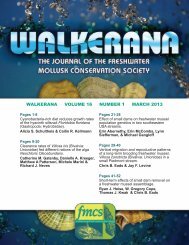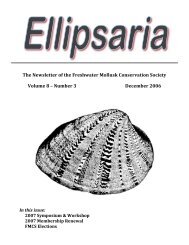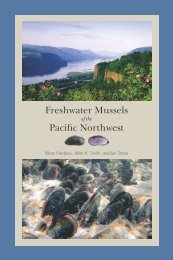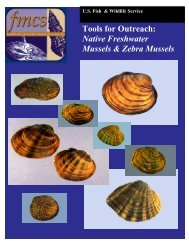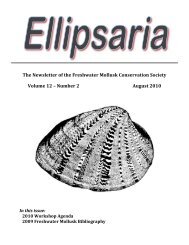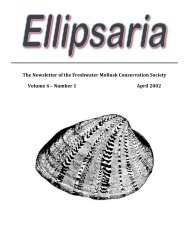August 2004 - FMCS-Freshwater Mollusk Conservation
August 2004 - FMCS-Freshwater Mollusk Conservation
August 2004 - FMCS-Freshwater Mollusk Conservation
Create successful ePaper yourself
Turn your PDF publications into a flip-book with our unique Google optimized e-Paper software.
Malacologia – XV EBRAM, Julho 21 a 25 de 1997, p.<br />
59.<br />
Guterres, Patrícia Macedo de Castro & Luís Fernando dos<br />
Reis Guterres. 1997c. Crescimento de Melampus<br />
coffeus (Linnaeus, 1758) (Pulmonata, Ellobiidae) no<br />
Rio Mampituba, Torres, Rio Grande do Sul, Brasil.<br />
Florianópolis, SC: Resumos XV Encontro Brasileiro de<br />
Malacologia – XV EBRAM, Julho 21 a 25 de 1997, p.<br />
59.<br />
15<br />
Pereira, Paulo Antonio Cypriano. 1993. Sobre o encontro<br />
de formas albinas em uma populacao de Chilina Gray,<br />
1828 (Mollusca; Gastropoda; Chilinidae), no canhao do<br />
Malacara, Praia Grande, Santa Catarina. Rio de Janeiro,<br />
RJ: Programa e Resumos XIII Encontro Brasileiro de<br />
Malacologia – XIII EBRAM, Julho de 1993, p. 81.<br />
A review of the United States distribution of Melanoides tuberculatus<br />
(Müller, 1774), an exotic freshwater snail<br />
Tamara K. Anderson<br />
University of Colorado Museum<br />
Boulder, Colorado<br />
Address for Correspondence: 285 Smith Street, Lander, Wyoming 82520<br />
E-mail: tamander@onewest.net<br />
INTRODUCTION<br />
Melanoides tuberculatus (Müller, 1774), the red-rim melania, is native to Africa, the Middle East, and southeast Asia (Pilsbry<br />
and Bequaert 1927), but is now common in tropical to semi-tropical areas around the globe. The species is live-bearing and<br />
generally considered to be parthenogenetic, although evidence exists for sexual reproduction in some populations (Livshits and<br />
Fishelson 1983; Heller and Farstey 1990). M. tuberculatus is a secondary host of several parasites that affect various species of<br />
fish and birds.<br />
Melanoides tuberculatus has invaded many areas of the globe with varying effects on the local gastropods. Abbott (1973) noted<br />
its spread into Puerto Rico, Mexico, and central America in the 1970s. M. tuberculatus may have a competitive advantage over<br />
native snails due to its ability to reach high densities (Pontier et al. 1991). In Mexico, the arrival of M. tuberculatus coincided<br />
with decreases in native gastropod populations (Contreras-Arquieta et al. 1995, as cited in Contreras-Arquieta 1998). Several<br />
studies in the Caribbean also showed negative impacts on Biomphalaria glabrata (Pointier and McCullough 1989; Pointier et al.<br />
1989; Pointier 1993). M. tuberculatus may also have contributed to the decline in B. glabrata in Venezuela (Pontier et al. 1994).<br />
In Africa, however, M. tuberculatus does not appear to displace freshwater pulmonate snails (Mkoji et al. 1992). Due to the<br />
potential effects on the aquatic community, the distribution of this species is important to track.<br />
METHODS<br />
In July 2001, I surveyed aquatic mollusks in Bridal Veil Falls and portions of Cascade Creek, Cool Creek, and the Cheyenne<br />
River on The Nature Conservancy's Whitney Preserve and adjacent properties in southwestern South Dakota. An informal<br />
sampling design allowed baseline information to be gathered with a minimum effort. The substrate at eleven points was sampled<br />
using a net and sieve bucket.<br />
In addition to my own survey results in South Dakota, I used available literature sources to research locations of Melanoides<br />
tuberculatus. Through the internet, I found records of occurrence at the Florida Natural History Museum, the Philadelphia<br />
Academy of Natural Sciences, and the Smithsonian Institution. Database searches at the Illinois Natural History Museum, the<br />
Bailey-Mathews Shell Museum, and the National Museums and Galleries of Wales failed to yield any U.S. records for M.<br />
tuberculatus. I visited the Field Museum of Natural History in Chicago and searched their collections in person. Contacts at the<br />
Delaware Museum of Natural History, the University of Michigan, and the Santa Barbara Museum of Natural History provided<br />
records from those collections. Personal communications with others who had recent field observations resulted in additional<br />
location information.<br />
RESULTS<br />
Shells of Melanoides tuberculatus were collected from one point in Cascade Creek. The water temperature at the collecting site<br />
was 21 o C. The shells measured from 5.3 mm to 13.8 mm in length. Robert Herschler confirmed the identification of the samples<br />
(pers. com.). Voucher specimens were deposited at the Field Museum of Natural History in Chicago (Voucher #296306).<br />
The known current distribution of Melanoides tuberculatus is summarized in Figure 1 and Table 1*. The distribution discussed<br />
here is limited to museum records, published literature reports, and personal communications with other scientists known to be



